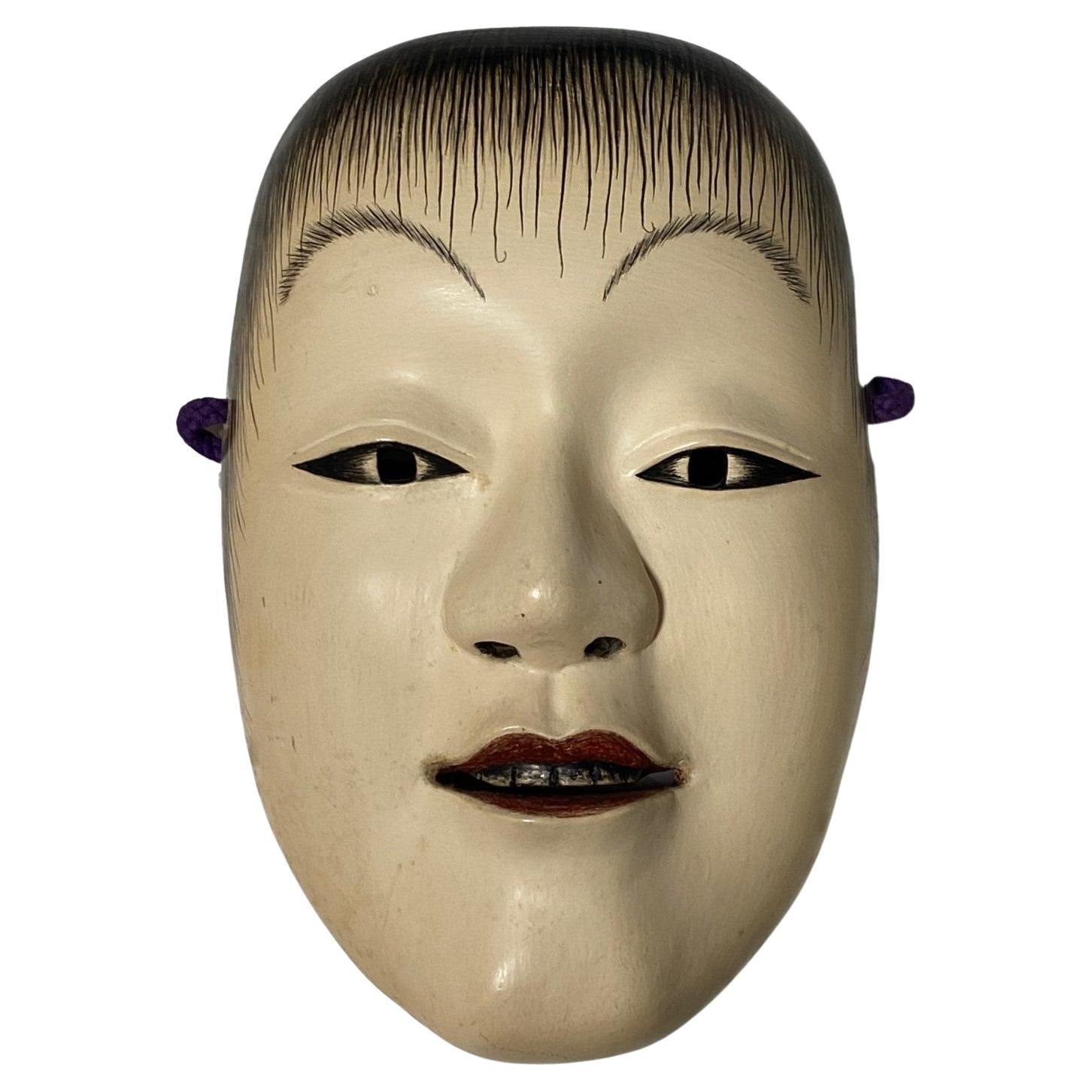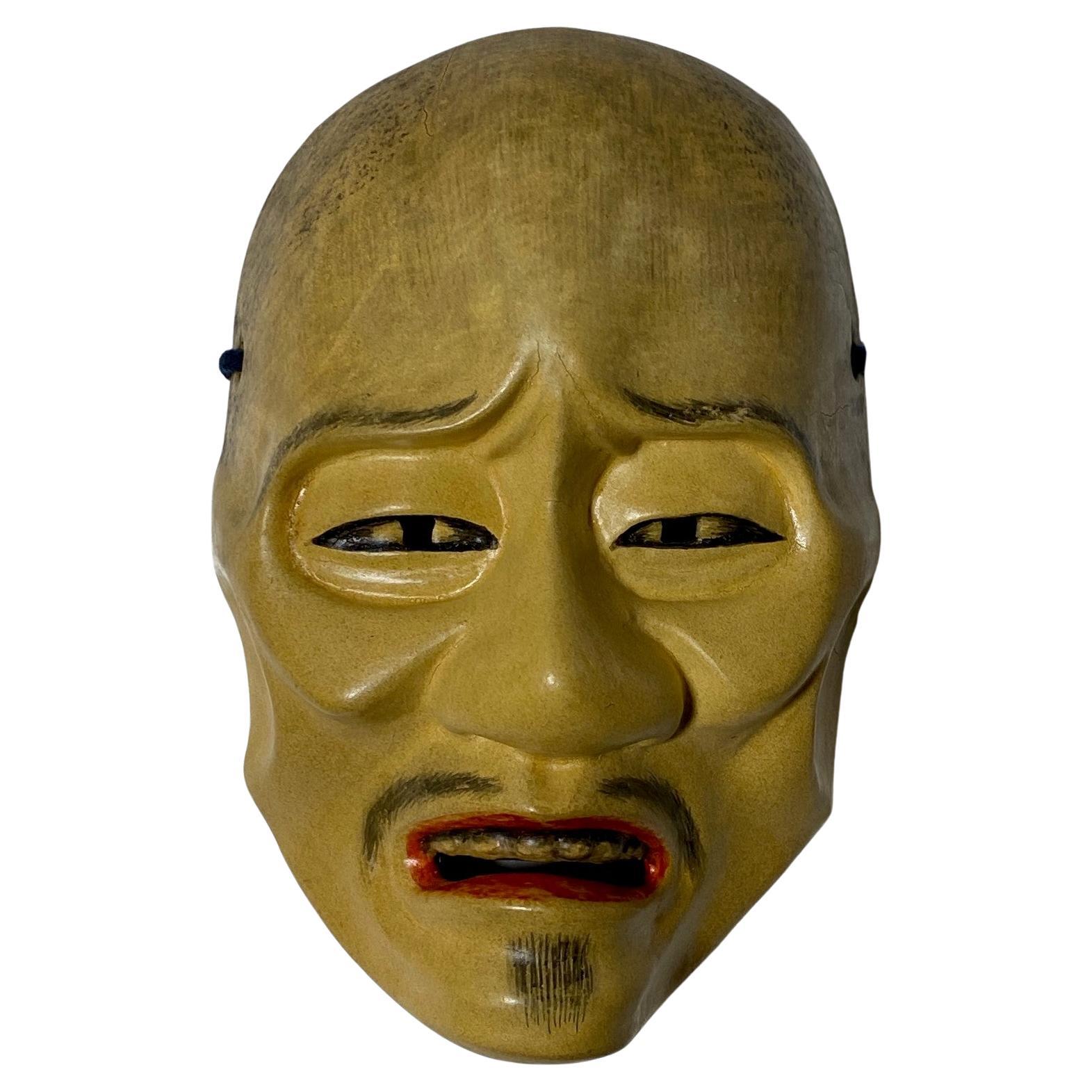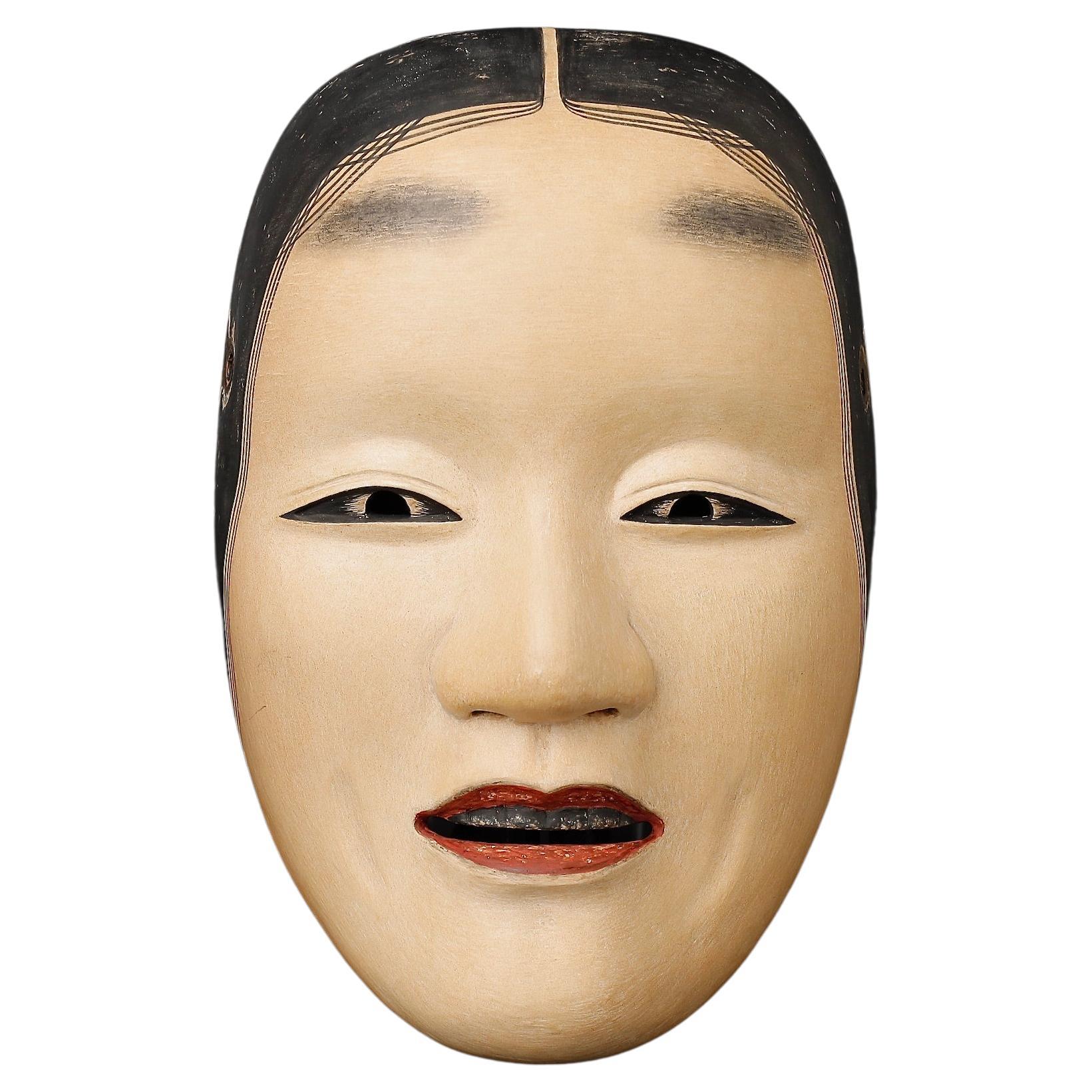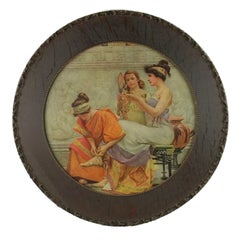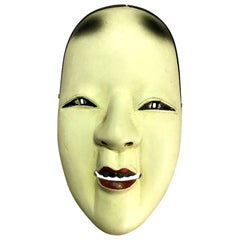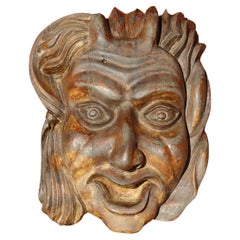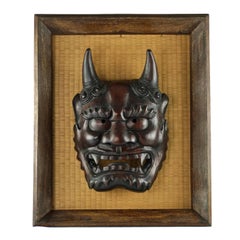
Framed Japanese Carved Wood Noh Hannya Mask on Grasscloth
View Similar Items
Want more images or videos?
Request additional images or videos from the seller
1 of 11
Framed Japanese Carved Wood Noh Hannya Mask on Grasscloth
About the Item
- Dimensions:Height: 23.25 in (59.06 cm)Width: 19.5 in (49.53 cm)Depth: 5.5 in (13.97 cm)
- Style:Edo (In the Style Of)
- Materials and Techniques:
- Place of Origin:
- Period:
- Date of Manufacture:Unknown
- Condition:Wear consistent with age and use. Very good condition.
- Seller Location:Cincinnati, OH
- Reference Number:Seller: 1126039181stDibs: LU119125884203
About the Seller
4.9
Vetted Seller
These experienced sellers undergo a comprehensive evaluation by our team of in-house experts.
Established in 2011
1stDibs seller since 2015
114 sales on 1stDibs
More From This SellerView All
- Hand Carved Wood Figural Bull StatueLocated in Cincinnati, OHThis skillfully executed hand carved figural bull is fully dimensional and has a rich brown color. The bull is depicted in a standing position atop a shaped wooden plinth. The muscular animal has been finished with realistic detail with particular attention given to the bull's facial features and folds of skin. The plinth itself is slightly domed at the center and bears carved elements which include a large rock and stylized plants. The bull measures 8" tall and the base is 10.75" x 4.125". It weighs 1lb 15oz. The carved bull is in very good vintage condition with no cracks or signs of wear. This early 20th century hand carved bull statue...Category
Early 20th Century Unknown Folk Art Animal Sculptures
MaterialsWood
- 19th Century Black Forest Carved Bear Motif Wood Box with Swing-Out CompartmentLocated in Cincinnati, OHThis unusual antique Black Forest box features a pair of fully dimensional bears cavorting at the base of a tree stump. The mother and cub hav...Category
Antique Late 19th Century German Black Forest Sculptures and Carvings
MaterialsGlass, Wood
- Early 20th Century Emilio Vasarri Lithograph in Arts & Crafts Wood FrameBy Emilio VasarriLocated in Cincinnati, OHThis rare early 20th century lithograph depicts an image originally executed by Italian artist Emilio Vasarri in 1909. The piece features a scene from classical antiquity and depicts...Category
Early 20th Century Unknown Pre-Raphaelite Prints
MaterialsOak, Paper
- Rubboli Lustre Majolica Double-Handled Compote with Mask Head DetailBy RubboliLocated in Cincinnati, OHThis early 20th century piece of Italian lustreware was made by the renowned Rubboli family pottery in the Umbrian town of Gualdo Tadino, Italy. Italian lustreware Majolica production traces its origins to the Renaissance. The art was revived in Gualdo Tadino during the last quarter of the 19th century, largely due to the efforts of ceramist Paolo Rubboli. Rubboli established his pottery in the region around 1870, and became known for the high quality of his distinctive cobalt, red and gold Neo-Renaissance lustreware. Rubboli's wife Daria and sons Lorenzo and Alberto continued Paolo's efforts after his death in 1890, and joined the newly formed consortium Societa Ceramica Umbria in 1920. Rubboli pieces dating to the period are marked with a blue underglaze "SCU" in a triangle mark along with a conjoined "PR" monogram in homage to Paolo's work. This large ceramic Neo-Renaissance Rubboli double handled compote is finished in cobalt, red and gold lustre. The piece consists of a round bowl at the top with elongated applied handles at either side, all of which rest upon a pedestal base. The bowl features two bas-relief winged mask heads on the exterior which have been depicted with open mouths sprouting handles in the form of serpent-like forked tongues. The exterior is also painted with pairs of imposing gryphons, each of which flank a large urn. The interior of the bowl is also heavily decorated and bears a fantastical winged lion set at the center of a series of scrolling acanthus leaves and urns, best seen in image 8. The remainder of the piece is finished with foliate and geometric motifs. It is of note that a similar piece was included in the traveling exhibit of important Majolica and lusterware entitled 'The Rubboli Collection - Italian lustre pottery in Gualdo Tadino' held in the Chiesa Monumentale di San Francesco between July 17 – October 3, 2010. The compote is in excellent original condition with no restorations or repairs. There are some glaze skips present on the piece as well as minor chips at the base of the pedestal foot which do not detract from the appearance of the compote and are mentioned for accuracy. The underside of the piece bears the blue underglaze Rubboli family Società Ceramica Umbra mark cited above consisting of the letters “SCU” within a triangle along with the entwined Paolo Rubboli 'PR' monogram, which was used from 1920 to 1931. The 3lb 5oz compote stands...Category
Vintage 1920s Italian Renaissance Revival Centerpieces
MaterialsCeramic
- Late 19th Century Signed Japanese Hand Painted Satsuma Temple Jar Meiji PeriodLocated in Cincinnati, OHThis outstanding late 19th century Japanese Satsuma porcelain covered temple jar has a traditional form with a domed lid. The piece features exquisite hand painted decoration which includes brightly hued flowers and associated foliage along with highly detailed jewel-toned butterflies with gilt highlights, all of which are on a shaded blue ground. The jar and lid also bear large chrysanthemums executed in heavy white enamel with underlying hints of green. The collar of the jar and edge of the lid have wide gilt bands finished with fine incised linear decoration that has been accented with blue, black and white enamel. The underside of the jar is hand lettered with characters reading Dai Nippon...Category
Antique 1880s Japanese Meiji Ceramics
MaterialsCeramic
- Shearwater Carved Pottery VaseBy Peter Anderson, James McConnell (Mac) AndersonLocated in Cincinnati, OHThis beautiful vase was made by renowned Shearwater Pottery of Ocean Springs, Mississippi. Shearwater was founded in 1928 by Peter Anderson and went...Category
Vintage 1940s American Arts and Crafts Vases
MaterialsPottery
You May Also Like
- Japanese Okame Ko-Omote Wood Carved Noh Theater MaskLocated in Studio City, CAA beautiful, wonderfully crafted, alluring mask made for Japanese Noh theatre. This mask is handcrafted and carved from natural wood. Ko-omote translates as "little mask" or sometimes "small face." This particular delicate featured mask (her red lips really stand out) is used for main and sometimes secondary roles when the character is a young girl or, in some cases, a supernatural being. What is also interesting about this mask is the blackened teeth which centuries ago, was customary for Japanese women to paint their teeth black after they became married. We believe this mask dates from the mid-to early Showa period, perhaps Mejia. The mask was acquired from an antique mask...Category
Mid-20th Century Japanese Showa Sculptures and Carvings
MaterialsWood
- Late 19th/Early 20th Century Carved Hannya Noh Devil Mask CurioLocated in Lowestoft, GBA rather cheeky looking carved and stained wood devil mask, turn off the century in age. Possibly reference to the Hannya Noh Mask used within Japanese th...Category
Antique Late 19th Century European Masks
MaterialsPine
- Japanese Antique Edo Hand Carved Wood Noh Theater Mask Otobide 17th-18th CenturyLocated in Studio City, CAA truly beautiful, wonderfully aged, alluring mask made for Japanese Noh theater. The naturally faded beauty and unique character drew us to this mask immediately. The mask is handcrafted and hand-carved from natural wood, clearly by a master of his trade. We believe this mask is of the Noh theatre character Otobide. This mask dates back to the Edo Period (1603-1868). It comes with a wooden storage box (which may have been added at a later date). A rare, unique, and exquisite mask. Finely carved and executed. Would be a great addition to any Japanese or Asian art/artifacts collection or an eye-catching stand-alone accent piece in about any setting. Mask dimensions: 7.7" high, 5.7" wide, 2.1" deep...Category
Antique 18th Century Japanese Edo Sculptures and Carvings
MaterialsWood, Lacquer, Paint
- Japanese Signed Hand Carved Wood Noh Theater Mask of Doji, Early Showa PeriodLocated in Studio City, CAA beautiful, wonderfully crafted, alluring mask made for Japanese Noh theatre. The mask is handcrafted and hand-carved from natural wood and is signed by the maker. This mask is of the immortal character Doji who symbolizes perpetual and eternal youth ("doji" literally translates as "child") in the Noh theater world. He is portrayed as a handsome male...Category
Mid-20th Century Japanese Showa Masks
MaterialsWood
- Japanese Signed Showa Hand Carved Wood Noh Theater Mask of Buddhist Monk ShunkanLocated in Studio City, CAA beautifully carved, wonderfully crafted, highly engaging mask made for Japanese Noh theatre. The mask is handcrafted and hand carved from natural wood and is signed and sealed b...Category
20th Century Japanese Showa Masks
MaterialsWood
- Japanese Signed Hand Carved Wood Noh Theater Mask of Chujo, Early Showa PeriodLocated in Studio City, CAA beautiful, wonderfully crafted, alluring mask made for Japanese Noh theatre. The mask is handcrafted and hand-carved from natural wood and is signed by the maker, clearly a mast...Category
Mid-20th Century Japanese Showa Masks
MaterialsWood, Paint
Recently Viewed
View AllMore Ways To Browse
Antique Shadowbox Frames
Noh Mask
Oversized Wooden Frame
Japanese Noh Mask
Japanese Demon
Wooden Mask Japan
Demon Folk Mask
Hannya Mask
Antique Hannya Mask
Vintage Mexican Wood Masks
African Hand Craft Wood Mask
Papua New Guinea Masks
Wall Decor Mask
African Beaded Masks
Halloween Mask
Senufo Mask
Baule Mask
African Mask Ghana



